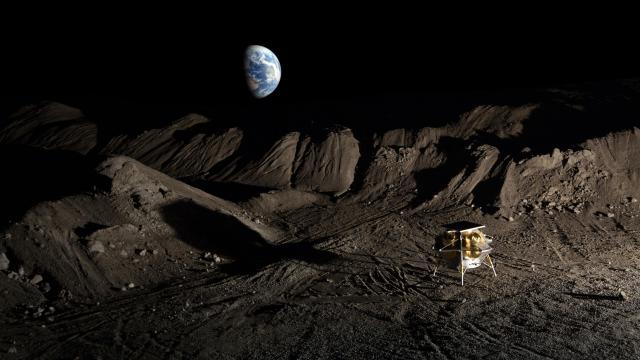The dreaded announcement arrived yesterday in a tweet, with Astrobotic admitting that, as a result of a catastrophic propellant leak, there’s “no chance of a soft landing on the Moon.” Mission specialists are scrambling to salvage what they can, but the much-hyped Peregrine-1 lunar mission is effectively over, with a faulty valve being the likely culprit.
United Launch Alliance launched the Astrobotic-developed Peregrine lander aboard its Vulcan Centaur rocket on January 8. This mission, part of NASA’s Commercial Lunar Payload Services (CLPS) under the Artemis program, marked a pivotal moment, as it was the first of its kind under this initiative. The Peregrine-1 mission garnered significant attention, as it was set to be the first launch of a U.S. lunar lander since the Apollo era and aimed to make history as the first commercial lunar lander to touch down on the Moon. But unfortunately, it’s not to be.
Weighing 2,829 pounds (1,283 kilograms), the Peregrine lander was not just a spacecraft. It was poised to be a pioneering cargo delivery service to the Moon, carrying 21 diverse payloads, including scientific instruments for NASA, Mexico, Germany, and the United Kingdom, along with an assortment of other items, including a student-built rover, a physical bitcoin, time capsules, art pieces, and the cremated remains of over 200 people.
Peregrine’s untimely demise will undoubtedly stir debate about NASA’s practice of working with private companies. It’s a frustrating setback, no doubt, but the mission failure can’t let us lose sight of the goals. NASA’s new reliance on the private sector is driven by its need to operate within constrained budgets, but there’s more to it than that. This approach not only fosters and stimulates the economy—it’s poised to play a vital role in ensuring success in space exploration.
Private Moon power
Astrobotic, among other commercial firms eyeing the Moon, is working under NASA’s CLPS program. Through this initiative, the space agency is seeking to set up commercial delivery services to the Moon, in which partnered companies transport rovers, robots, and other experiments to the lunar surface. CLPS is an important element of NASA’s Artemis program, which aims to blend the space agency’s expertise with private-sector skills and technology.

Under contracts totaling $US2.6 billion through 2028, various companies are tasked with roles such as assembling payloads and pulling off lunar landings. Among these are Astrobotic and Intuitive Machines, working under NASA contracts valued at $US79.5 million (the final figure ended up being closer to $US108 million) and $US77 million, respectively. Intuitive Machines plans to launch at least two missions to the Moon later this year.
Peregrine-1 was the first to launch under CLPS, in what is now an inauspicious start for the program. As industry experts explain, however, it’s important for NASA to stay the course.
The Moon is hard
“While the Astrobotic mission’s status is certainly a disappointment, I don’t think we have to worry about the CLPS program too much just yet,” Wendy N. Whitman Cobb, professor of strategy and security studies at the U.S. Air University’s School of Advanced Air and Space Studies, said in an email.
Indeed, and as Whitman Cobb pointed out, an upsetting number of Moon-bound missions have failed recently, whether private or public. Israel’s Beresheet and India’s Chandrayaan-2 lander crashed onto the lunar surface in 2019; Russia’s Luna-25 and Japan’s ispace Hakuto-R M1 met the same fate last year.
“Even in the 1960s, the U.S. had a very difficult time landing uncrewed probes on the Moon in the Ranger program. Of course, all of those missions at least got to lunar orbit, unlike Peregrine, which certainly adds to the disappointment,” Whitman Cobb said. “But I don’t think we should necessarily be surprised by lunar mission failures, simply because of the long track record demonstrating that things like this are very hard to do.”
Spread the risk
Michael Lembeck, associate professor of practice in aerospace engineering at The Grainger College of Engineering at the University of Illinois Urbana-Champaign, has likewise not lost faith in CLPS, saying the initiative is designed to let NASA diversify its risks, avoiding too much dependence on just one contractor or technology and thereby lessening the overall effect of any single mission’s failure. “This diversification encourages different approaches and innovations, increasing the chances of success in the long run,” Lembeck wrote in an email.
Whitman Cobb believes that NASA never expected a perfect success rate for the program. While CLPS serves to boost commercial space development, it also lets NASA diversify its investments, ensuring that, if one mission fails, there are others ready to proceed. The aforementioned missions from Intuitive Machines, the first of which is set to blast off next month, are good examples.
Faster, better, cheaper
Greg Autry, director of the Thunderbird Initiative for Space Leadership, Policy and Business at the Thunderbird School of Global Management, says there’s no reason to believe that this recent failure is uniquely linked to the commercial model of lunar exploration.
The whole point of CLPS, according to Autry, “was to find a way for NASA to embrace the power of the commercial approach, which embraces failure as a necessary component of a faster and cheaper, iterative development process.” When establishing CLPS, space agency officials expected some failures, but with lower costs and a quicker pace than what NASA could achieve on its own, he explained.
“NASA has famously learned that, in the ‘faster, better, cheaper’ triangle, you can get two of those outcomes,” Autry wrote in an email. “CLPS was directly aimed at the ‘faster-cheaper’ corner of the triangle. Most other NASA programs have been stuck on the ‘better’ side of the triangle, unable to capture the power of a corner, because of systemic risk intolerance.”
Facing a future with reduced federal discretionary budgets, the agency can’t afford to manage all projects like the Webb Space Telescope or Mars Sample Return, in which cost and time seem limitless because “failure is not an option,” Autry explained, adding that they also require the private capital that initiatives like CLPS bring to the table.
Whitman Cobb says NASA adopted the “faster, better, cheaper” mantle in the early 1990s, aiming to accelerate planetary and science missions by cutting costs and simultaneously undertake multiple projects. But that approach was “ultimately brought down by one too many mission failures, so while I don’t think we need to worry too much about CLPS right now, if missions continue to fail, I think that’s when we’ll start to see more concern,” she explained.
Failure is an option
It’s not a good look for NASA, a taxpayer-funded entity, to repeatedly fail. Private companies, by contrast, are not bound by this restriction, as exemplified by SpaceX, which consistently employs its “move fast and break things” strategy to great effect. As Lembeck points out, failures in the commercial sector are frequently treated as informative successes.
“The commercial space industry’s approach to rapid testing and iteration means that these lessons can be learned and applied more rapidly than more risk averse, traditional approaches,” Lembeck said. In this latest example, “NASA will participate in the assessment of the lander anomaly, Astrobotic will rectify the cause of Peregrine’s propulsion system failure, and the information shared will allow other CLPS providers to reduce their risks as well.”
Whitman Cobb agrees, saying that SpaceX and other New Space companies have shown that failures are okay and not final. “Just because one Astrobotic mission failed does not mean that they’re suddenly out of the game,” Whitman Cobb said. “If anything, watching these companies fail over the years only to eventually succeed has probably increased NASA’s and the public’s risk tolerance.”
The bottom line, says Autry, is that this is a learning process. “I am disappointed but not surprised by the outcome. Astrobotic will be back with better results,” he said.
It’s the economy, stupid
There’s an obvious economic upside to CLPS. Although Astrobotic didn’t achieve a lunar landing, its strategy has yielded significant economic and technological benefits, including job creation and the development of innovative technologies like radiation-resistant, high-speed avionics and AI-supported navigation systems, according to Lembeck.
“These advancements will enable more frequent, diverse, and ambitious space missions at a fraction of the traditional cost, benefiting both the government and taxpayers,” he said. “When considered collectively, these factors justify the government’s investment in the CLPS program, highlighting its strategic value beyond the current mission’s objectives.”
Just the start
The loss of Peregrine and its precious cargo really sucks, but there’s no need to lose hope, at least not yet. The lessons learned will guide Astrobotic and other companies toward safer and more successful missions in the future. With this first unsuccessful attempt, however, NASA’s CLPS now finds itself under the microscope. Time will tell if the space agency’s outsourcing strategy will pay off as intended.
For more spaceflight in your life, follow us on X (formerly Twitter) and bookmark Gizmodo’s dedicated Spaceflight page.
